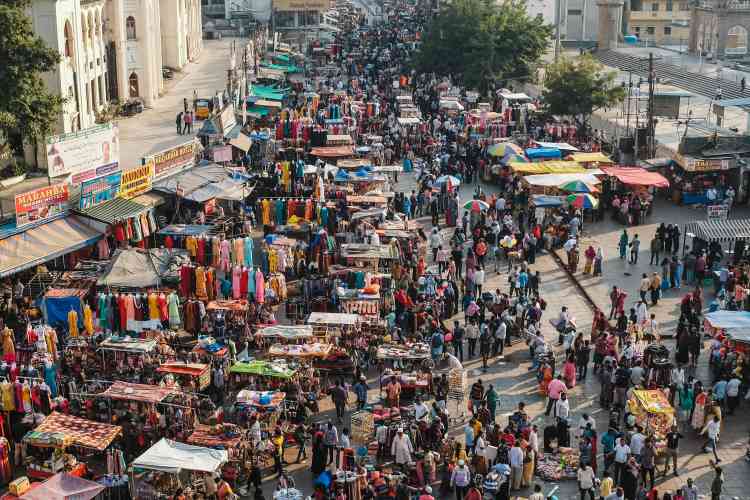
Indian economy faces headwinds: Global economic uncertainties and escalating trade tensions are casting a long shadow over the world economy. India, though expected to remain the fastest-growing major economy, will not be entirely insulated from these pressures. In its June 2025 Global Economic Prospects report, the World Bank retained India’s growth projection for FY26 at 6.3%, following a downward revision of 40 basis points in April. The multilateral lender cited weakening global demand, persistent trade frictions, and elevated policy uncertainty as major drags on investment momentum.
The growth outlook for FY27 and FY28 stands at 6.5% and 6.7%, respectively. While these figures remain robust relative to global peers, they fall short of the pace required for India to attain high-income status by its centenary in 2047. According to internal NITI Aayog estimates, India must sustain annual GDP growth above 8% for the next two decades to meet this ambition.
READ | Scrap SEZs — Make India one giant factory floor
Investment and trade: Slipping gears
The World Bank’s downgrade of India’s FY26 forecast—by 0.4 percentage points since January—was largely attributed to slowing exports, driven by subdued activity in key trading partners and rising global trade barriers. Investment growth is also moderating, reflecting greater global uncertainty and weaker private sector sentiment.
This is not a challenge unique to India. The World Bank has downgraded growth forecasts for nearly 70% of the world’s economies, bringing its 2025 global growth estimate down to just 2.3%—the lowest since 2008, excluding periods of global recession. The January forecast had stood at 2.7%. Although the global economy is not projected to enter recession in the next two years, the slowdown is unmistakable and unevenly distributed.
The deceleration in the developing world is especially pronounced. “Outside of Asia, the developing world is becoming a development-free zone,” noted Indermit Gill, Chief Economist at the World Bank. Growth in developing economies has slowed from 6% in the 2000s to under 4% in the 2020s. This mirrors a broader decline in global trade volumes and investment growth, even as sovereign and corporate debt pile up to record levels.
Indian economy and Trump’s tariff gambit
Further complicating matters is the recent decision by the Trump administration to enforce reciprocal tariffs on April 2, 2025—only to suspend them 90 days later amid trade negotiations. The tariffs, targeting allies as well as strategic rivals, have introduced volatility into financial markets and triggered retaliatory measures. While the US hopes to leverage tariffs into trade concessions, this approach has rattled supply chains and amplified investor anxiety.
If trade talks yield a resolution, global GDP could see a modest boost of 0.2 percentage points in 2025 and 2026, according to World Bank simulations. But failure to de-escalate tensions may keep commodity prices elevated, inflate input costs, and stall investment decisions across developing economies.
Domestic levers at play
In a bid to sustain growth momentum, the Reserve Bank of India surprised markets by cutting the repo rate by 50 basis points in June—bringing the total easing in 2025 to 100 bps. With headline retail inflation expected to average a benign 3.7% in FY26, the RBI’s Monetary Policy Committee is shifting focus from inflation control to supporting consumption and private investment.
Yet monetary policy alone cannot counter external headwinds. Industrial production in April 2025 slowed sharply, with the Index of Industrial Production (IIP) falling to 2.7%—an eight-month low. This suggests that manufacturing, mining, and electricity output are all facing stress. Meanwhile, Q4 FY25 corporate earnings reflected subdued sales growth and margin compression, underscoring weak demand and persistent global uncertainty.
The slowdown is not yet a crisis. But if left unaddressed, it risks morphing into a structural drag on job creation and capital formation—particularly at a time when India hopes to anchor itself in realigned global value chains.
What must India do
First, policy agility is critical. A coordinated fiscal-monetary response—alongside faster public investment deployment—can cushion the blow of external shocks. States must be roped in through targeted capital expenditure allocations and fiscal incentives to drive infrastructure development and job creation.
Second, India must aggressively diversify its export markets beyond the US and EU. The geopolitical rift with Washington, exacerbated by tariff tensions, only reinforces this urgency. Greater integration with ASEAN, Africa, and Latin America—via trade agreements and production partnerships—can reduce overdependence on a handful of Western economies.
Third, India must move up the value chain in strategic sectors such as electronics, semiconductors, green hydrogen, and pharmaceuticals. While the Production-Linked Incentive (PLI) scheme has created momentum, implementation bottlenecks persist. Speedier clearances, better logistics, and reliable power supply will be key to unlocking the scheme’s full potential.
Lastly, domestic capital formation must be revived through investor-friendly reforms. These include faster resolution under the Insolvency and Bankruptcy Code (IBC), predictable tax policies, and further easing of doing business for MSMEs and startups. The recent hike in capital gains tax on private equity exits—though aimed at revenue—risks damping investor enthusiasm if not accompanied by compensatory measures.
As an earlier Policy Circle article noted, the world is entering a phase of economic fragmentation. Growth alone will no longer define resilience. Credibility, consistency, and capacity for reform will shape a nation’s fortunes.
India’s macro fundamentals—healthy foreign exchange reserves, low inflation, and a proactive monetary stance—remain strengths. But to prevent its growth story from slipping from impressive to merely adequate, India must reimagine its playbook. The global tide may not turn in its favour any time soon. It must swim against it—with skill, strategy, and resolve.
